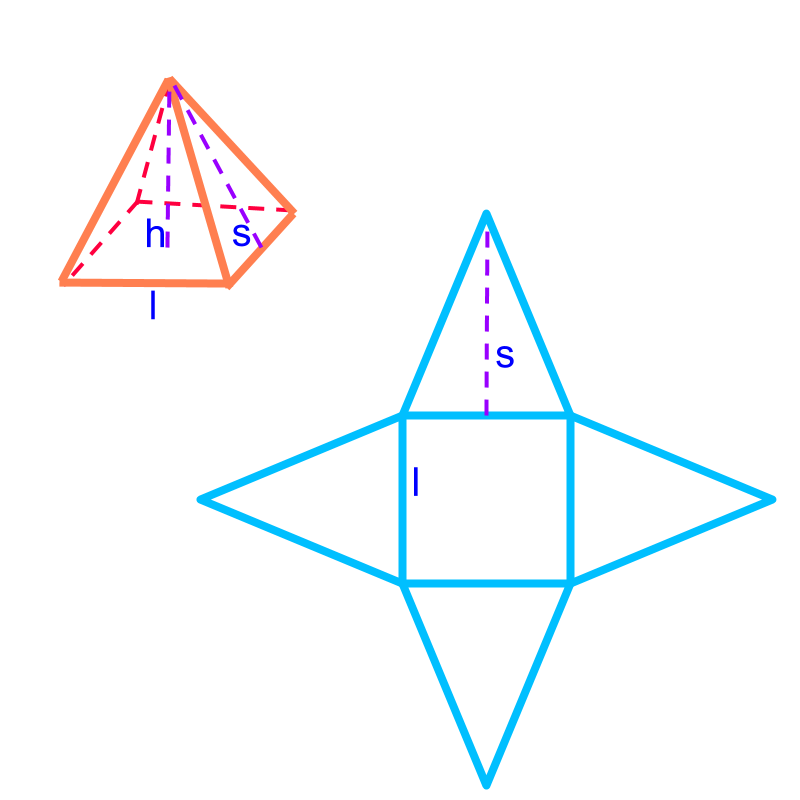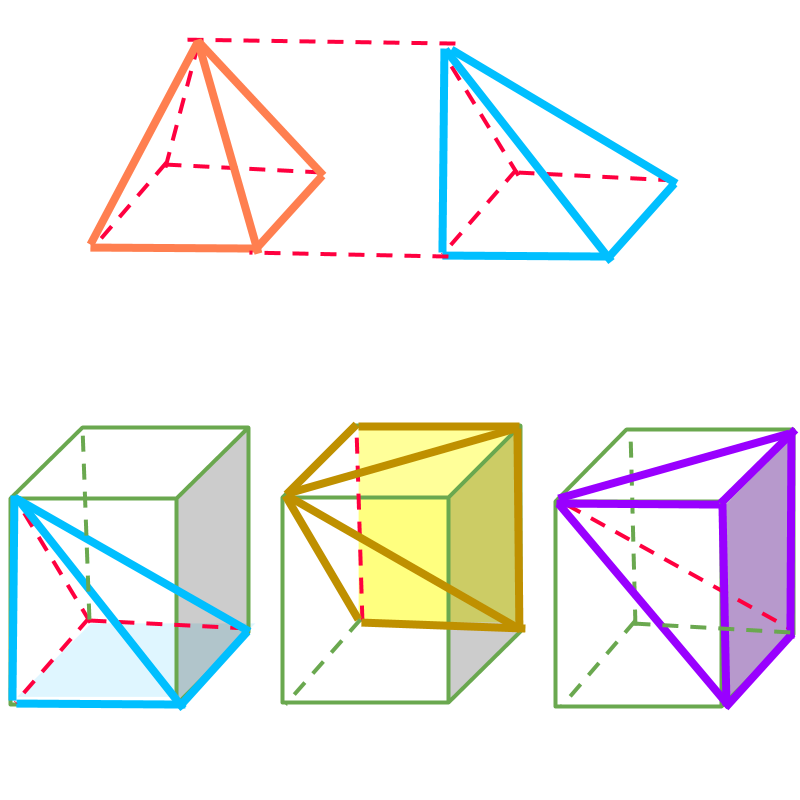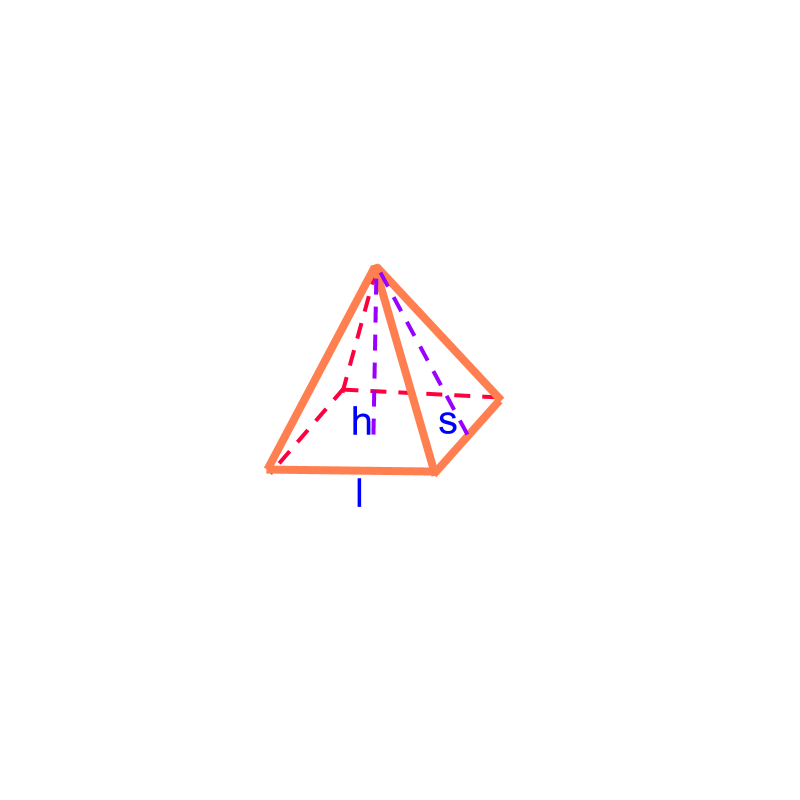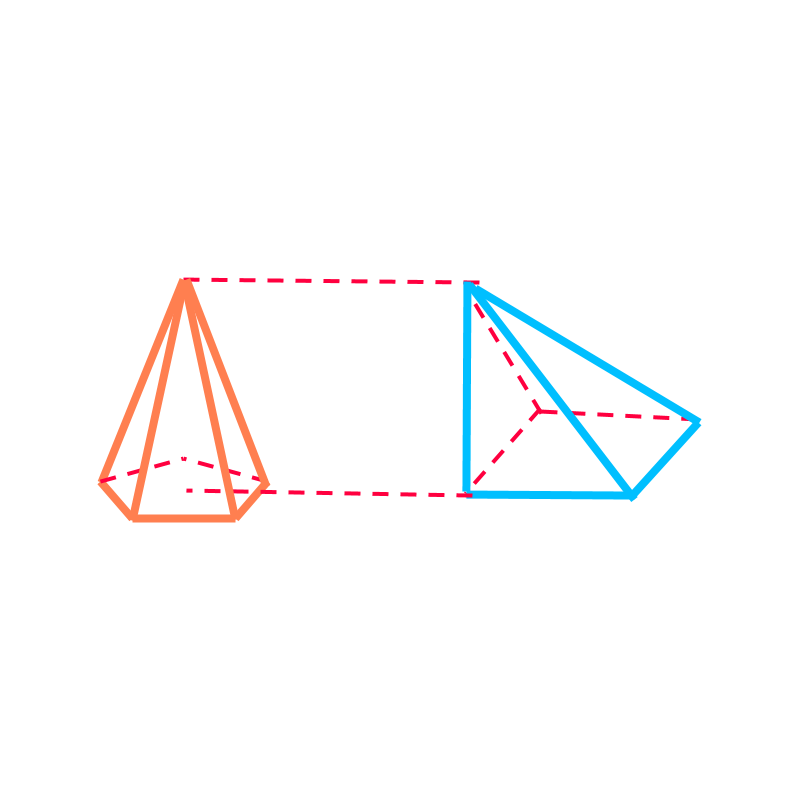
what you'll learn...
Overview
Surface Area and Volume of pyramid:
 Total surface area of the pyramid
Total surface area of the pyramid
area of the base-surface sum of the area of the side-faces
 Volume of the pyramid
Volume of the pyramid
pyramid

The shape shown in the figure is "a pyramid". Pyramid is a 3D solid shape with a 2D-polygon base at the bottom with triangular faces on the sides converging to a single point on the top . The base can be any 2D-polygon, for example, square, rectangle, triangle, etc, and the pyramids are square-pyramid, rectangular-pyramid, triangular-pyramid respectively.

We consider only right-pyramids with its axis at right angle to the base-surface. The oblique-pyramids have the angle between its axis and the base is not a right-angle. A right pyramid is shown in orange. And an oblique pyramid is shown in blue.
surface area

The surface area of the square-pyramid of side and height is
or
Note: A generic pyramid consists of
base-surface a 2D-polygon, (in this problem a square)
a set of triangular faces, (in this problem triangles of base and height ).
is the slant height computed as .

A pyramid of height is shown in orange. The triangular faces are shown in blue. Total surface area of the pyramid
area of the base-surface sum of the area of the triangular faces
volume of square pyramid

The volume of the square-pyramid of side and height is
Note: As per the Cavalieri's principle in 3D, the pyramid is equivalently represented by the oblique-pyramid in blue.
The modified-pyramid fits into a cuboid. Each of the pyramids in blue, green, and purple, equal in volume, fit into the cuboid, and spans the entire cuboid. So, each fills exactly one-third of the cuboid as shown.
A square-pyramid of height is shown in orange. As per the Cavalieri's principle in 3D, the pyramid is equivalently represented by the oblique-pyramid in blue.
The modified-pyramid fits into a cuboid. Each of the pyramids, shown on the lower half of the figure, in blue, green, and purple, are
• equal in volume,
• fit into the cuboid, and
• spans the entire cuboid.
So, each fills exactly one-third of the cuboid as shown.
Volume of the pyramid
volume of the modified pyramid with identical cross sectional area along vertical axis
volume of any pyramid
The volume of the pentagonal-pyramid shown in the figure is

A pentagonal-pyramid is shown in orange. As per the Cavalieri's principle in 3D, the pyramid is equivalently represented by the oblique-pyramid in blue.
The modified-pyramid has
• the area at the bottom surface equal to the pentagonal pyramid
• the height equal to the pentagonal pyramid.
• the cross-sectional area at any point along vertical axis equals to the same of pentagonal pyramid
Volume of the pyramid
volume of the modified pyramid with identical cross sectional area along vertical axis
What is the volume of a pyramid with base area and height cm? Volume can be computed without specifying what type of pyramid is that. Volume base-area height
summary
Surface Area and Volume of pyramid:
 Total surface area of the pyramid
Total surface area of the pyramid
area of the base-surface sum of the area of the side-faces
 Volume of the pyramid
Volume of the pyramid
Outline
The outline of material to learn Mensuration : Length, Area, and Volume is as follows.
Note 1: click here for the detailed overview of Mensuration High
Note 2: click here for basics of mensuration, which is essential to understand this.
• Basics of measurement
→ Summary of Measurement Basics
→ Measurement by superimposition
→ Measurement by calculation
→ Measurement by equivalence
→ Measurement by infinitesimal pieces
→ Cavalieri's Principle (2D)
→ Cavalieri's Principle (3D)
• Perimeter & Area of 2D shapes
→ Circumference of Circles
→ Area of Circles
• Surface area & Volume of 3D shapes
→ Prisms : Surface Area & Volume
→ Pyramids : Surface Area & Volume
→ Cone : Surface Area & Volume
→ Sphere : Surface Area & Volume
• Part Shapes
→ Understanding part Shapes
→ Circle : Sector and Segment
→ Frustum of a Cone